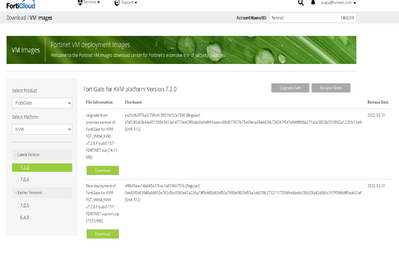- Support Forum
- Knowledge Base
- Customer Service
- Internal Article Nominations
- FortiGate
- FortiClient
- FortiADC
- FortiAIOps
- FortiAnalyzer
- FortiAP
- FortiAuthenticator
- FortiBridge
- FortiCache
- FortiCare Services
- FortiCarrier
- FortiCASB
- FortiConverter
- FortiCNP
- FortiDAST
- FortiData
- FortiDDoS
- FortiDB
- FortiDNS
- FortiDLP
- FortiDeceptor
- FortiDevice
- FortiDevSec
- FortiDirector
- FortiEdgeCloud
- FortiEDR
- FortiEndpoint
- FortiExtender
- FortiGate Cloud
- FortiGuard
- FortiGuest
- FortiHypervisor
- FortiInsight
- FortiIsolator
- FortiMail
- FortiManager
- FortiMonitor
- FortiNAC
- FortiNAC-F
- FortiNDR (on-premise)
- FortiNDRCloud
- FortiPAM
- FortiPhish
- FortiPortal
- FortiPresence
- FortiProxy
- FortiRecon
- FortiRecorder
- FortiSRA
- FortiSandbox
- FortiSASE
- FortiSASE Sovereign
- FortiScan
- FortiSIEM
- FortiSOAR
- FortiSwitch
- FortiTester
- FortiToken
- FortiVoice
- FortiWAN
- FortiWeb
- FortiAppSec Cloud
- Lacework
- Wireless Controller
- RMA Information and Announcements
- FortiCloud Products
- ZTNA
- 4D Documents
- Customer Service
- Community Groups
- Blogs
- Fortinet Community
- Knowledge Base
- FortiGate
- Technical Tip: How to add a FortiGate VM into the ...
- Subscribe to RSS Feed
- Mark as New
- Mark as Read
- Bookmark
- Subscribe
- Printer Friendly Page
- Report Inappropriate Content
Created on
01-05-2023
07:47 AM
Edited on
09-25-2024
07:07 AM
By
![]() Jean-Philippe_P
Jean-Philippe_P
| Description |
This article describes how to add a FortiGate VM to the GNS3. |
| Scope | FortiGate v6.0, 6.2, 6.4 ,7.0, 7.2, 7.4, 7.6. |
| Solution |

Proceed with the following steps to add the FortiGate:
Select 'Browse all appliances' and select new template. Select 'Install an appliance' from the GNS3 server and select 'Next':
Expand the firewall under appliance name, select FortiGate, and press install. The various version from GNS3 directories will be then visible. If the FortiOS version is not listed, it is possible to create a new version.
Lates version might not be listed because GNS3 needs to update its repositories.
The latest FortiOS version listed on GNS3 version 2.2.49, is FortiOS 7.4.4, but version 7.6.0 will be imported.
Rename image filename as per filename that was downloaded from Fortinet Support Portal.
As soon as the image is installed on the server, it will be possible to view it on the left panel where all devices are listed..
Other Fortinet devices can be added the same way. By doing a simple search for Fortinet products on New Template wizard, it will display results of what devices are currently supported by GNS3 by default, without further workarounds.
All is set to create a basic topology with a FortiGate and other devices if needed, and connect to one of VMs from the local system.
For that, it is necessary to drag the FortiGate or FortiManager, or both of them at the same time. In GNS3 go to File ->New Blank Project and create a basic topology as shown below and start the machine
Connect to the FortiGate console and assign the IP to the connected interface. In this topology, the VM Nat-ed IP is in 192.168.82.x/24 subnet. IP will be assigned to port1 from the above subnet range i.e., 192.168.82.2.
Once the IP address has been assigned, it is now possible to access the FortiGate GUI from the local browser window. The IP to access the GUI will be the port1 IP.
|
The Fortinet Security Fabric brings together the concepts of convergence and consolidation to provide comprehensive cybersecurity protection for all users, devices, and applications and across all network edges.
Copyright 2025 Fortinet, Inc. All Rights Reserved.










